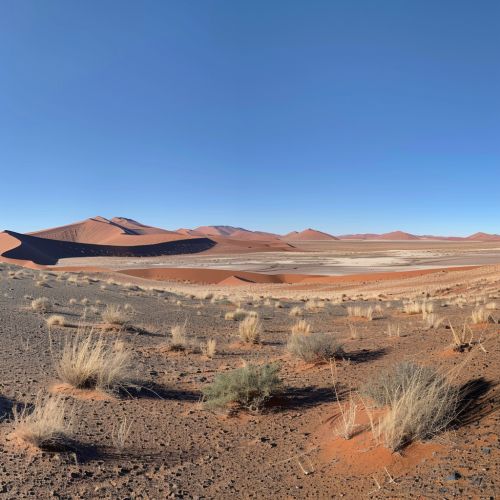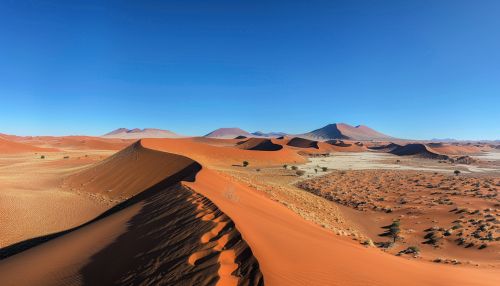Sossusvlei
Geography
Sossusvlei is located in the southern part of the Namib Desert, in the Namib-Naukluft National Park of Namibia. The name "Sossusvlei" is of mixed origin and roughly translates to "dead-end marsh". Vlei is the Afrikaans word for "marsh", while "sossus" is Nama for "no return" or "dead end". Sossusvlei owes this name to the fact that it is an endorheic drainage basin for the ephemeral Tsauchab River.


Geology
The Sossusvlei area is characterized by high sand dunes of vivid pink-to-orange color, an indication of a high concentration of iron in the sand and consequent oxidation processes. The oldest dunes are those of a more intense reddish color. These dunes are among the highest in the world; many of them are above 200 metres, the highest being the one nicknamed Big Daddy, about 325 metres high.
The clay pan was formed after rainfall, when the Tsauchab river flooded, creating temporary shallow pools where the abundance of water allowed camel thorn trees to grow. When the climate changed, drought hit the area, and sand dunes encroached on the pan, which blocked the river from the area.
Flora and Fauna
Despite the harsh desert conditions, Sossusvlei has a wide array of flora and fauna. Vegetation, such as the camelthorn tree, is watered by infrequent floods of the Tsauchab River, which slowly soak into the underlying clay. The flora is not only surviving, but thriving in its own way.
In terms of fauna, a variety of insects, rodents, and small reptiles can be found. Larger animals include oryx, springbok, and ostrich. The area is also home to several species of birds.
Tourism
Sossusvlei is a popular tourist destination in Namibia. Due to the clear light and clean air, this area is also a hotspot for photographers attempting to capture the beautiful scenery. The best time to visit is close to sunrise and sunset; the colors are strong and constantly changing, allowing for stunning photographs.
See Also
- Namib-Naukluft National Park - Namib Desert - Big Daddy (dune)
